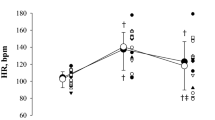Summary
The direct cortical response (DCR) and associated local cerebral blood flow was recorded from the primate cerebral cortex during a period of focal ischaemia induced by middle cerebral artery occlusion (MCAO). The DCR was lost when local blood flow fell below 20ml/ 100g/min but began to recover as collateral flow increased. Hypercapnia demonstrated a loss of local vascular reactivity following MCAO, but isovolaemic haemodilution still proved effective in increasing blood flow to these areas. The reduction in blood oxygen content induced by haemodilution did not impair cerebral function but the reduction in whole blood viscosity did exacerbate cerebral susceptibility to hypercapnia-induced intra-cerebral steal.
Similar content being viewed by others
Abbreviations
- DCR:
-
direct cortical response
- CBF:
-
cerebralblood flow
- MCAO:
-
middle cerebral artery occlusion
- RBC:
-
redblood cell
- SEP:
-
somatosensory evoked potential
- MABP:
-
mean arterial blood pressure
- EEG:
-
electroencephalogram
References
Branston NM, Symon L, Crockard HA, Pasztor E (1974) Relationships between the cortical evoked potential and local cortical blood flow following acute middle cerebral artery occlusion in the baboon. Exp Neurol 45: 195–208
Branston NM, Ladds A, Symon L, Wang AD (1984) Comparison of the effects of ischaemia on early components of the somatosensory evoked potential in brainstem, thalamus and cerebral cortex. J Cereb Blood Flow Metab 4: 68–81
Brown MM, Wade JP, Marshall J (1985) Fundamental importance of arterial oxygen content in the regulation of cerebral blood flow in man. Brain 108: 81–93
Cavestri R, Pelucchi A, Mastropasqua B, Agosti R, LeGrazie C, Longhini E (1986) Effects of isovolemic hemodilution in acute cerebral ischemia. Clinical Haemorheology 6: 381–394
Chan R, Leiniger-Follert E, Mähig A (1983) Effect of isovolaemic hemodilution on oxygen supply and electrocorticgram in cat brain during focal ischemia and in normal tissue. Int J Microcirc 2: 297–313
Coyer PE, Lesnick JE, Michele JJ, Simeone FA (1986) Failure of the somatosensory evoked potential following middle cerebral artery occlusion and high-grade ischaemia in the cat. Effect of hemodilution. Stroke 17: 37–43
Farman C, Kawauchi M, Symon L (1990) Plasma viscosity may influence cerebral blood flow during hypervolaemic haemodilution. In: Krieglestein J, Oberpichler H (eds) Pharmacology of cerebral ischaemia 1990. Wissenschaftliche Verlagsgesellschaft, Stuttgart, pp 519–525
Farman C, Kawauchi M, Symon L (1991) Hypervolaemic haemodilution improves cerebral blood flow to focally ischaemic regions devoid of vascular autoregulation. J Cereb Blood Flow Metab 11 [Suppl 2]: S 751
Grotta JC (1987) Can raising cerebral blood flow improve outcome after acute cerebral infarction? Stroke 18: 264–267
Harris RJ, Richards PG, Symon L, Habib AHA, Rosenstein J (1987) pH, K+, and PO2 of the extracellular space during ischaemia of primate cerebral cortex. J Cereb Blood Flow Metab 7: 599–604
Hartmann A (ed) (1989) Hemorheology. Acta Neurol Scand 80 [Suppl 127]: 1–48
Hint H (1968) The pharmacology of dextran and the physiological background for the clinical use of rheomacrodex and macrodex. Acta Anaesthesiol Belg 19: 119–138
Humphrey PRD, duBoulay GH, Marshall J, Pearson TC, Ross Russell RW, Symon L, Wetherley-Mein G, Zilkha E (1979) Cerebral blood flow and viscosity in relative polycythaemia. Lancet ii: 873–877
Korosue K, Heros RC, Ogilvy CS, Hyodo A, Tu YK, Graichen R (1990) Comparison of crystalloids and colloids for haemodilution in a model of focal cerebral ischemia. J Neurosurg 73: 576–584
Kusunoki M, Kimura K, Nakamura M, Isaka Y, Yoneda S, Abe H (1981) Effects of hematocrit variations on cerebral blood flow and oxygen transport in ischaemic cerebrovascular disease. J Cereb Blood Flow Metab 1: 413–417
Maruyama M, Shimoji K, Ichikawa T, Hashiba M, Naito E (1985) The effect of extreme hemodilutions on the autoregulation of cerebral blood flow, electroencephalogram and cerebral metabolic rate of oxygen in the dog. Stroke 16(4): 675–679
Momma F, Sabin HI, Branston NM, Symon L (1988) The effect of experimental ischaemia on the direct cortical response of the motor cortex in primates. EEG Clin Neurophysiol 71: 304–309
Pasztor EL, Symon L, Dorsch NWC, Branston NM (1973) The hydrogen clearance method in assessment of blood flow in cortex, white matter, and deep nuclei of baboons. Stroke 4: 556–567
Strand T, Asplund K, Eriksson S, Hagg E, Lithner F, Wester PO (1984) A randomized controlled trial of hemodilution therapy in acute ischemic stroke. Stroke 15: 980–989
Sunder-Plassmann L, Klovekorn WP, Messmer K (1972) Hemodynamic and rheological changes induced by hemodilution with colloids. In: Messmer K, Schmid-Schonbein H (eds) Hemodilution. Theoretical basis and clinical application. Karger, Basel, pp 184–202
Symon L, Pasztor E, Branston NM (1974) The distribution and density of reduced cerebral blood flow following acute middle cerebral artery occlusion. An experimental study by the technique of hydrogen clearance in baboons. Stroke 5: 355–364
Thomas DJ, duBoulay GH, Marshall J, Pearson TC, Ross Russell RW, Symon L, Wetherley-Mein G, Zilkha E (1977) Effect of haematocrit on cerebral blood flow in man. Lancet ii: 941–943
Tu YK, Heros RC, Candia G, Karacostas D, Hyodo A, LaGree K, Callahan R, Zervas NT, Karacostas D (1988) Isovolemic hemodilution in experimental focal cerebral ischemia, Part I: effects on hemodynamics, hemorheology and intracranial pressure. J Neurosurg 69: 72–81
Wood JH, Simeone FA, Fink EA, Golden MA (1984) Correlative aspects of hypervolaemic hemodilution with low molecular weight dextran after experimental cerebral arterial occlusion. Neurology 34: 24–34
Wood JH, Kee DB (1985) Hemorheology of the cerebral circulation in stroke. Stroke 16: 765–772
Author information
Authors and Affiliations
Rights and permissions
About this article
Cite this article
Farman, C., Chen, Z.P., Branston, N. et al. The effect of haemodilution and hypercapnia on the recovery of cerebral function from experimental focal ischaemia. Acta neurochir 127, 210–214 (1994). https://doi.org/10.1007/BF01808768
Issue Date:
DOI: https://doi.org/10.1007/BF01808768



